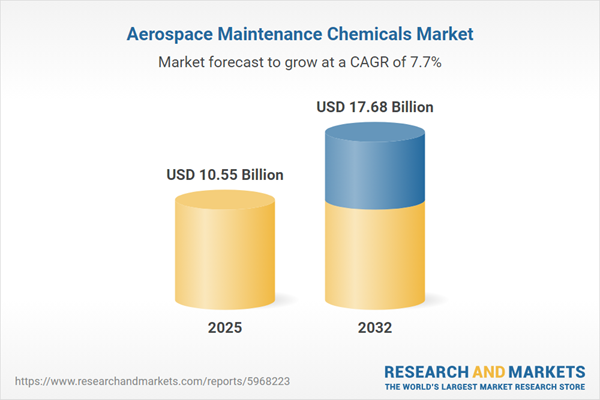Speak directly to the analyst to clarify any post sales queries you may have.
Senior leaders in the aerospace sector are navigating increased complexity as sustainability, regulatory compliance, and supply chain resilience transform procurement practices. This report delivers essential market intelligence for the aerospace maintenance chemicals market, ensuring executives can make informed decisions to align operational reliability with innovation and traceability.
Aerospace Maintenance Chemicals Market Snapshot
In 2024, the global aerospace maintenance chemicals market reached USD 9.78 billion, reflecting the strong influence of heightened regulatory standards and a sector-wide emphasis on environmental best practices. Innovation in material science and advancements in digital technologies are streamlining core maintenance functions. Commercial airlines, defense agencies, and general aviation players increasingly depend on specialized chemical solutions to mitigate operational risk and embed sustainable practices. The adoption of targeted chemicals supports safer, more efficient maintenance while addressing the demands of diverse global fleets and expansive supply networks.
Aerospace Maintenance Chemicals Market: Scope & Segmentation
This report offers executive-ready frameworks and deep segmentation for airlines, maintenance and repair organizations (MROs), original equipment manufacturers (OEMs), and defense agencies. The scope enables agile selection, procurement, and investment strategies grounded in sustainability and compliance.
- Product Types: Solutions include removers, solvent and aqueous cleaners, dry ice systems, various corrosion inhibitors, oil-based and synthetic lubricants, performance greases, coatings, paints, primers, and adhesives—each addressing the complex requirements of aerospace maintenance.
- Application Areas: Key functions comprise bonding, sealing, degreasing, general and specialized cleaning, corrosion protection, surface lubrication, and coating removal. These support optimal safety and maintenance efficiency.
- Aircraft Categories: Tailored products are available for rotorcraft, narrow-body and wide-body commercial aircraft, regional jets, and turboprops, supporting varied operational demands and specific maintenance profiles.
- End Users: Airlines, defense bodies, MROs, and OEMs shape their procurement and day-to-day operations around the effectiveness of these chemical solutions in maintaining compliance, safety, and overall productivity.
- Platform Focus: Chemical compatibility is required for both new and legacy platforms in commercial, military, and general aviation, with a necessity to maintain traceability throughout the value chain.
- Maintenance Types: Both scheduled and unscheduled maintenance cycles depend on specialized chemicals to enhance uptime and check operational interruptions.
- Sales Channels: Direct supplier and distributor networks support transparency and continuity for complex aerospace supply chains across global markets.
- Regional Coverage: The Americas, Europe, Middle East, Africa, and Asia-Pacific each face unique regulatory and infrastructure pressures, driving region-specific sourcing and supplier strategies.
Industry leaders such as PPG Industries, Akzo Nobel, Henkel, Dow Chemical Company, and Solvay continue to invest in digitalization, automation, and transparent supply chains. Increasing reliance on automated and digital systems is helping harmonize processes and safeguard compliance for mission-critical fleet maintenance.
Key Takeaways for Senior Decision-Makers
- Regulatory pressures are encouraging the shift to compliant and sustainable chemical alternatives, prioritizing environmental criteria in procurement processes.
- Expanding automation and robotics use is reducing manual intervention in maintenance, which directly supports improved safety and more reliable, standardized outcomes.
- Proactive management of supplier portfolios ensures compatibility with evolving airframe materials and aims to protect long-term operational performance.
- Collaboration between suppliers, OEMs, and MROs enhances transparency across the supply chain and allows faster adaptation to regulatory or technological updates.
- Region-specific and localized sourcing strategies—most notably in Asia-Pacific and the Middle East—increase compliance while minimizing disruptions from legal or logistical volatility.
- Streamlined validation and auditing methods enable geographically distributed maintenance teams to standardize compliance and operational efficiency.
Tariff Impact: Navigating U.S. Policy Shifts in 2025
Anticipated changes in U.S. tariff policy for 2025 are prompting aerospace organizations to reevaluate sourcing strategies. Building robust domestic supply networks and developing contingency plans offer procurement teams greater flexibility to manage cost fluctuations and mitigate risks related to tariff-driven market shifts affecting maintenance chemicals.
Methodology & Data Sources
This market analysis is based on comprehensive secondary research, industry-verified data, and direct interviews with aerospace sector authorities. All findings have been rigorously validated, providing senior executives with reliable, actionable information to inform procurement and operational decisions.
Why This Report Matters
- Integrates sustainability and compliance considerations into executive procurement and maintenance strategies during a period of sector-wide transformation.
- Provides in-depth market segmentation and supplier benchmarking to support resilience and supply chain agility for diverse fleets and regions.
- Identifies pathways for leveraging digitalization and sustainable chemistry, optimizing both resource efficiency and organizational resilience.
Conclusion
By clarifying critical trends in maintenance chemicals and procurement strategies, this report gives aerospace leaders the insight needed to enhance fleet reliability and maintain regulatory alignment as industry demands evolve.
Additional Product Information:
- Purchase of this report includes 1 year online access with quarterly updates.
- This report can be updated on request. Please contact our Customer Experience team using the Ask a Question widget on our website.
Table of Contents
3. Executive Summary
4. Market Overview
7. Cumulative Impact of Artificial Intelligence 2025
Companies Mentioned
The companies profiled in this Aerospace Maintenance Chemicals market report include:- PPG Industries, Inc.
- Akzo Nobel N.V.
- Henkel AG & Co. KGaA
- The Dow Chemical Company
- Solvay S.A.
- E. I. du Pont de Nemours and Company
- Huntsman International LLC
- Element Solutions Inc.
- Momentive Performance Materials Inc.
- CRC Industries, Inc.
Table Information
| Report Attribute | Details |
|---|---|
| No. of Pages | 187 |
| Published | October 2025 |
| Forecast Period | 2025 - 2032 |
| Estimated Market Value ( USD | $ 10.55 Billion |
| Forecasted Market Value ( USD | $ 17.68 Billion |
| Compound Annual Growth Rate | 7.6% |
| Regions Covered | Global |
| No. of Companies Mentioned | 11 |









